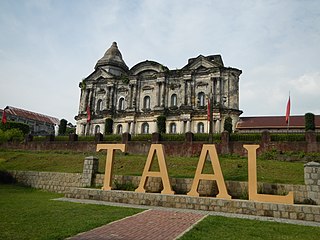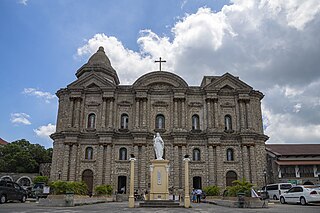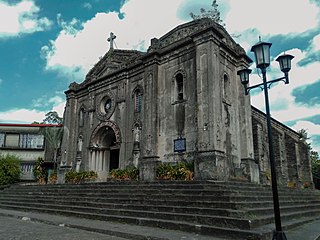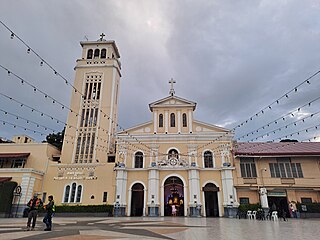
A shrine to the Virgin Mary, or Marian shrine, is a shrine marking an apparition or other miracle ascribed to the Blessed Virgin Mary, or a site on which is centered a historically strong Marian devotion. Such locales are often the destinations of Christian pilgrimages.

Batangas, officially the Province of Batangas, is a first class province of the Philippines located in the southwestern part of Luzon in the Calabarzon region. Its capital is the city of Batangas, and is bordered by the provinces of Cavite and Laguna to the north, and Quezon to the east. Across the Verde Island Passages to the south is the island of Mindoro and to the west lies the South China Sea. Poetically, Batangas is often referred to by its ancient name, Kumintáng.

Lipa, officially the City of Lipa, is a 1st class component city in the province of Batangas, Philippines. According to the 2020 census, it has a population of 372,931 people.

The Basilica of Santa María de Guadalupe, officially called Insigne y Nacional Basílica de Santa María de Guadalupe is a basilica of the Catholic Church, dedicated to the Virgin Mary in her invocation of Our Lady of Guadalupe, located at the foot of the Hill of Tepeyac in the Gustavo A. Madero borough of Mexico City. It belongs to the Primate Archdiocese of Mexico through the Guadalupana Vicariate, which since November 4, 2018, is in the care of Monsignor Efraín Hernández Díaz, who has the title of general and episcopal vicar of Guadalupe and abbot of the basilica.

The Basilica of the National Shrine of the Blessed Virgin of Ta' Pinu is a Roman Catholic minor basilica and national shrine located some 700 metres (2,300 ft) from the village of Għarb on the island of Gozo, the sister island of Malta.

Taal, officially the Municipality of Taal, is a 3rd class municipality in the province of Batangas, Philippines. According to the 2020 census, it has a population of 61,460 people.

Paco Catholic School is a co-institutional private school located in the district of Paco in the City of Manila, Philippines. Paco Catholic school started in November, 1912 as an informal class for 50 young boys inside the chapel in the Peñafrancia section of the district by Raymond Esquinet, CICM, who was succeeded by Fr. Godofredo Aldenhuijsen, CICM. On May 14, 2022, in the 325th anniversary of the arrival of the Peñafrancia image in Manila and the 70th anniversary of the Parish, Jose Advincula solemnly declared the Paco Chapel, the same site of PCS, now Parish Church, the Archdiocesan Shrine of Our Lady of Peñafrancia.

The Minor Basilica and Parish of Saint Martin of Tours, also known as the Taal Basilica, is a minor basilica in the town of Taal, Batangas, within the Archdiocese of Lipa. It is considered to be the largest church building in the Philippines and in Asia, standing 88.6 meters (291 ft) long and 48 meters (157 ft) wide. Martin of Tours is the patron saint of Taal, whose feast is celebrated every November 11.

Our Lady of Caysasay is a Roman Catholic image of the Blessed Virgin Mary venerated at the Archdiocesan Shrine of Our Lady of Caysasay in Taal, Batangas, Philippines. The image depicts the Immaculate Conception is believed to be one of the oldest in the country, originally discovered in 1603 by a native man fishing in the Pansipit River. The subsequent Marian apparitions documented by Spanish colonial church leaders were the first in the country; devotees today continue to attribute miracles to the Virgin.

The National Shrine of Our Lady of the Candles, also known as the Metropolitan Cathedral of Saint Elizabeth of Hungary and colloquially as Jaro Cathedral, is a cathedral located in the district of Jaro in Iloilo City, on the island of Panay in the Philippines. The seat of the Roman Catholic Archdiocese of Jaro, it was placed under the patronage of Saint Elizabeth of Hungary. It was established in 1575 as a visita (chapel-of-ease) of Oton by the Augustinians and as a separate parish in 1587. The present-day structure of Jaro Cathedral was built in 1874.

The Nuestra Señora de Gracia Church, also known as Guadalupe Church, is a Baroque Roman Catholic church in Makati City, Philippines. The parish church and its adjacent monastery are currently administered by the Augustinian friars of the Province of Santo Niño de Cebu. The territory of the parish covers San Carlos Seminary, the major seminary of the Archdiocese of Manila and Our Lady of Guadalupe Minor Seminary. The church also has an adjacent seminary, the Monasterio de Guadalupe, which admits young professionals for priestly and religious vocation. The current parish priest is Rev. Fr. Aimark P. Asor, OSA.

Our Lady of Piat is a 16th-century Roman Catholic icon of the Blessed Virgin Mary enshrined in a minor basilca situated in Piat, Cagayan, Philippines. It is the town's and the province's patroness and is one of the most venerated Marian images of Mary in the Philippines, referred to as the "Mother of Cagayan".

The Our Lady of Guidance is a 16th-century image of the Blessed Virgin Mary depicted as the Immaculate Conception and widely venerated by Filipinos. The wooden Black Madonna is considered the oldest extant Marian statue in the Philippines. Locally venerated as patroness of navigators and travelers, the image is enshrined at the Ermita Church in the city of Manila.

The Basilica Minore of Our Lady of Piat is one of the twenty-one minor basilicas in the Philippines. Located at Poblacion, Piat, in the province of Cagayan, the shrine is dubbed as the "Pilgrimage Center of Northeast Luzon" and is home to the centuries-old brown Madonna Our Lady of Piat.

The Archdiocesan Shrine of Our Lady of the Assumption, commonly known as the Santa Maria Church and Santa Maria Pro-cathedral, is a Roman Catholic shrine in Santa Maria, Ilocos Sur, Philippines. The church was designated as a UNESCO World Heritage Site on December 11, 1993, as part of the Baroque Churches of the Philippines, a collection of four Baroque Spanish-era churches. It is currently the pro-cathedral of the Archdiocese of Nueva Segovia while the Vigan Cathedral is undergoing repairs.

The Minor Basilica and Parish of the Immaculate Conception, alternatively known as the Archdiocesan Shrine of Santo Niño de Batangan, is a minor basilica in Batangas City, Philippines. It is under the jurisdiction of the Archdiocese of Lipa. It was made an independent parish in 1614 under the advocation of the Immaculate Conception. It is one of the oldest churches in Batangas.

The Minor Basilica of Our Lady of the Rosary of Manaoag, commonly known as Manaoag Church, is a Roman Catholic minor basilica located in Manaoag, Pangasinan in the Philippines.

The Parish and National Shrine of Saint Padre Pio, commonly known as Padre Pio Shrine, is a Roman Catholic parish church and pilgrimage site situated along Governor Antonio Carpio Avenue in Barangay San Pedro, Santo Tomas, Batangas, Philippines. It is consecrated to the Italian Saint Pio of Pietrelcina.

The Diocesan Shrine and Parish of Our Lady of Mercy is a Roman Catholic church under the Diocese of Novaliches in the Philippines. It is the oldest parish in the diocese, established in 1856 by the Augustinian missionaries from Spain.

























